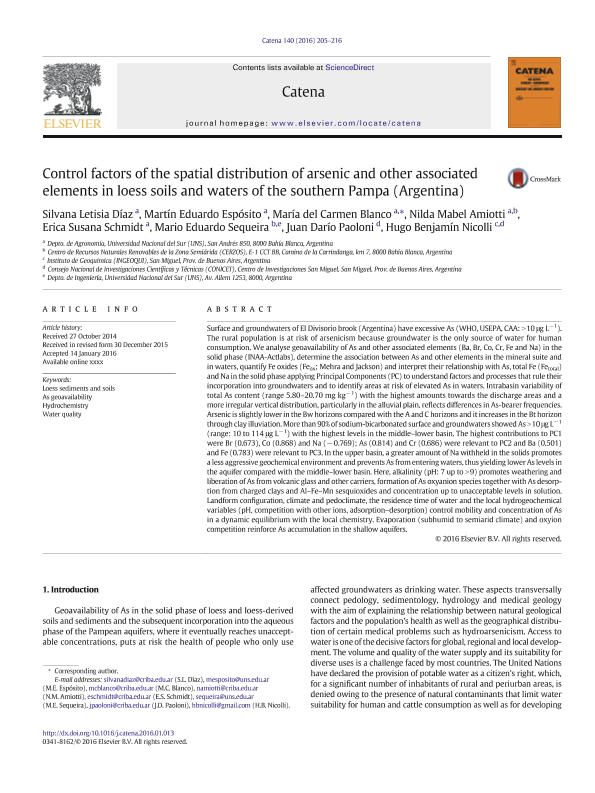Mostrar el registro sencillo del ítem
dc.contributor.author
Díaz, Silvana Letisia

dc.contributor.author
Espósito, Martín Eduardo

dc.contributor.author
Blanco, María del Carmen

dc.contributor.author
Amiotti, Nilda Mabel

dc.contributor.author
Schmidt, Erica Susana

dc.contributor.author
Sequeira, Mario Eduardo

dc.contributor.author
Paoloni, Juan Dario

dc.contributor.author
Nicolli, Hugo Benjamin

dc.date.available
2018-05-17T13:17:20Z
dc.date.issued
2016-05
dc.identifier.citation
Díaz, Silvana Letisia; Espósito, Martín Eduardo; Blanco, María del Carmen; Amiotti, Nilda Mabel; Schmidt, Erica Susana; et al.; Control factors of the spatial distribution of arsenic and other associated elements in loess soils and waters of the southern Pampa (Argentina); Elsevier Science; Catena; 140; 5-2016; 205-216
dc.identifier.issn
0341-8162
dc.identifier.uri
http://hdl.handle.net/11336/45444
dc.description.abstract
Surface and groundwaters of El Divisorio brook (Argentina) have excessive As (WHO, USEPA, CAA: > 10 μg L− 1). The rural population is at risk of arsenicism because groundwater is the only source of water for human consumption. We analyse geoavailability of As and other associated elements (Ba, Br, Co, Cr, Fe and Na) in the solid phase (INAA-Actlabs), determine the association between As and other elements in the mineral suite and in waters, quantify Fe oxides (Feox; Mehra and Jackson) and interpret their relationship with As, total Fe (Fetotal) and Na in the solid phase applying Principal Components (PC) to understand factors and processes that rule their incorporation into groundwaters and to identify areas at risk of elevated As in waters. Intrabasin variability of total As content (range 5.80–20.70 mg kg− 1) with the highest amounts towards the discharge areas and a more irregular vertical distribution, particularly in the alluvial plain, reflects differences in As-bearer frequencies. Arsenic is slightly lower in the Bw horizons compared with the A and C horizons and it increases in the Bt horizon through clay illuviation. More than 90% of sodium-bicarbonated surface and groundwaters showed As > 10 μg L− 1 (range: 10 to 114 μg L− 1) with the highest levels in the middle–lower basin. The highest contributions to PC1 were Br (0.673), Co (0.868) and Na (− 0.769); As (0.814) and Cr (0.686) were relevant to PC2 and Ba (0.501) and Fe (0.783) were relevant to PC3. In the upper basin, a greater amount of Na withheld in the solids promotes a less aggressive geochemical environment and prevents As from entering waters, thus yielding lower As levels in the aquifer compared with the middle–lower basin. Here, alkalinity (pH: 7 up to > 9) promotes weathering and liberation of As from volcanic glass and other carriers, formation of As oxyanion species together with As desorption from charged clays and Al–Fe–Mn sesquioxides and concentration up to unacceptable levels in solution. Landform configuration, climate and pedoclimate, the residence time of water and the local hydrogeochemical variables (pH, competition with other ions, adsorption–desorption) control mobility and concentration of As in a dynamic equilibrium with the local chemistry. Evaporation (subhumid to semiarid climate) and oxyion competition reinforce As accumulation in the shallow aquifers.
dc.format
application/pdf
dc.language.iso
eng
dc.publisher
Elsevier Science

dc.rights
info:eu-repo/semantics/openAccess
dc.rights.uri
https://creativecommons.org/licenses/by-nc-sa/2.5/ar/
dc.subject
Loess Sediments And Soils
dc.subject
As Geoavailability
dc.subject
Hidrochemistry
dc.subject
Water Quality
dc.subject.classification
Meteorología y Ciencias Atmosféricas

dc.subject.classification
Ciencias de la Tierra y relacionadas con el Medio Ambiente

dc.subject.classification
CIENCIAS NATURALES Y EXACTAS

dc.title
Control factors of the spatial distribution of arsenic and other associated elements in loess soils and waters of the southern Pampa (Argentina)
dc.type
info:eu-repo/semantics/article
dc.type
info:ar-repo/semantics/artículo
dc.type
info:eu-repo/semantics/publishedVersion
dc.date.updated
2018-05-04T21:23:37Z
dc.journal.volume
140
dc.journal.pagination
205-216
dc.journal.pais
Países Bajos

dc.journal.ciudad
Amsterdam
dc.description.fil
Fil: Díaz, Silvana Letisia. Consejo Nacional de Investigaciones Científicas y Técnicas; Argentina. Universidad Nacional del Sur. Departamento de Agronomía. Laboratorio de Hidrología y Riego; Argentina
dc.description.fil
Fil: Espósito, Martín Eduardo. Consejo Nacional de Investigaciones Científicas y Técnicas; Argentina. Universidad Nacional del Sur. Departamento de Agronomía. Laboratorio de Hidrología y Riego; Argentina
dc.description.fil
Fil: Blanco, María del Carmen. Universidad Nacional del Sur. Departamento de Agronomía. Laboratorio de Hidrología y Riego; Argentina
dc.description.fil
Fil: Amiotti, Nilda Mabel. Consejo Nacional de Investigaciones Científicas y Técnicas; Argentina. Universidad Nacional del Sur. Departamento de Agronomía. Laboratorio de Hidrología y Riego; Argentina
dc.description.fil
Fil: Schmidt, Erica Susana. Consejo Nacional de Investigaciones Científicas y Técnicas; Argentina. Universidad Nacional del Sur. Departamento de Agronomía. Laboratorio de Hidrología y Riego; Argentina
dc.description.fil
Fil: Sequeira, Mario Eduardo. Consejo Nacional de Investigaciones Científicas y Técnicas. Centro Científico Tecnológico Conicet - Bahía Blanca. Centro de Recursos Naturales Renovables de la Zona Semiárida. Universidad Nacional del Sur. Centro de Recursos Naturales Renovables de la Zona Semiárida; Argentina. Universidad Nacional del Sur. Departamento de Agronomía. Laboratorio de Hidrología y Riego; Argentina
dc.description.fil
Fil: Paoloni, Juan Dario. Consejo Nacional de Investigaciones Científicas y Técnicas; Argentina. Universidad Nacional del Sur. Departamento de Agronomía. Laboratorio de Hidrología y Riego; Argentina
dc.description.fil
Fil: Nicolli, Hugo Benjamin. Consejo Nacional de Investigaciones Científicas y Técnicas; Argentina. Ministerio de Defensa. Fuerza Aérea Argentina. Instituto de Geoquímica; Argentina
dc.journal.title
Catena

dc.relation.alternativeid
info:eu-repo/semantics/altIdentifier/url/https://www.sciencedirect.com/science/article/pii/S0341816216300157
dc.relation.alternativeid
info:eu-repo/semantics/altIdentifier/doi/http://dx.doi.org/10.1016/j.catena.2016.01.013
Archivos asociados
